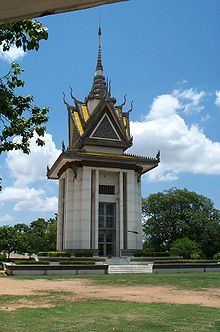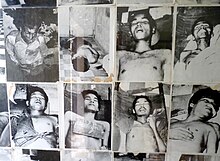Killing Fields
| Part of a series on |
| Genocide |
|---|
 |
| Issues |
| Related topics |
| Category |



The Killing Fields (Khmer: វាលពិឃាត, Khmer pronunciation: [ʋiəl pikʰiət]) are a number of sites in Cambodia where collectively more than one million people were killed and buried by the Khmer Rouge regime (the Communist Party of Kampuchea) during its rule of the country from 1975 to 1979, immediately after the end of the Cambodian Civil War (1970–1975). The mass killings are widely regarded as part of a broad state-sponsored genocide (the Cambodian genocide).
Analysis of 20,000 mass grave sites by the DC-Cam Mapping Program and Yale University indicates at least 1,386,734 victims of execution.[1][2] Estimates of the total deaths resulting from Khmer Rouge policies, including death from disease and starvation, range from 1.7 to 2.5 million out of a 1975 population of roughly 8 million. In 1979, Vietnam invaded Democratic Kampuchea and toppled the Khmer Rouge regime, ending the genocide.
The Cambodian journalist Dith Pran coined the term "killing fields" after his escape from the regime.[3]
The Khmer Rouge regime arrested and eventually executed almost everyone suspected of connections with the former government or with foreign governments, as well as professionals and intellectuals. Ethnic Vietnamese, ethnic Thai, ethnic Chinese, ethnic Cham, Cambodian Christians, and Buddhist monks were the demographic targets of persecution. As a result, Pol Pot has been described as "a genocidal tyrant".[4] Martin Shaw described the Cambodian genocide as "the purest genocide of the Cold War era".[5]
Ben Kiernan estimates that about 1.7 million people were killed.[6] Researcher Craig Etcheson of the Documentation Center of Cambodia suggests that the death toll was between 2 and 2.5 million, with a "most likely" figure of 2.2 million. After five years of researching some 20,000 grave sites, he concludes that "these mass graves contain the remains of 1,386,734 victims of execution".[7] A United Nations investigation reported 2–3 million dead, while UNICEF estimated 3 million had been killed.[8] Demographic analysis by Patrick Heuveline suggests that between 1.17 and 3.42 million Cambodians were killed,[9] while Marek Sliwinski suggests that 1.8 million is a conservative figure.[10] Even the Khmer Rouge acknowledged that 2 million had been killed—though they attributed those deaths to a subsequent Vietnamese invasion.[11] By late 1979, UN and Red Cross officials were warning that another 2.25 million Cambodians faced death by starvation due to "the near destruction of Cambodian society under the regime of ousted Prime Minister Pol Pot",[12][13] who were saved by international aid after the Vietnamese invasion.
Process

The judicial process of the Khmer Rouge regime, for minor or political crimes, began with a warning from the Angkar, the government of Cambodia under the regime. People receiving more than two warnings were sent for "re-education," which meant near-certain death. People were often encouraged to confess to Angkar their "pre-revolutionary lifestyles and crimes" (which usually included some kind of free-market activity; having had contact with a foreign source, such as a U.S. missionary, international relief or government agency; or contact with any foreigner or with the outside world at all), being told that Angkar would forgive them and "wipe the slate clean." They were then taken away to a place such as Tuol Sleng or Choeung Ek for torture and/or execution.[citation needed]
The executed were buried in mass graves. In order to save ammunition, the executions were often carried out using poison, spades or sharpened bamboo sticks. Inside the Buddhist Memorial Stupa at Choeung Ek, there is evidence of bayonets, knives, wooden clubs, hoes for farming and curved scythes being used to kill victims, with images of skulls, damaged by these implements, as evidence. In some cases the children and infants of adult victims were killed by having their heads bashed against the trunks of Chankiri trees, and then were thrown into the pits alongside their parents. The rationale was "to stop them growing up and taking revenge for their parents' deaths."[citation needed]
Some victims were required to dig their own graves; their weakness often meant that they were unable to dig very deep. The soldiers who carried out the executions were mostly young men or women from peasant families.
Prosecution for crimes against humanity
In 1997 the Cambodian government asked for the UN's assistance in setting up a genocide tribunal. It took nine years to agree to the shape and structure of the court—a hybrid of Cambodian and international laws—before the judges were sworn in, in 2006.[14][15][16] The investigating judges were presented with the names of five possible suspects by the prosecution on 18 July 2007.[14] On 19 September 2007 Nuon Chea, second in command of the Khmer Rouge and its most senior surviving member, was charged with war crimes and crimes against humanity. He faced Cambodian and foreign judges at the special genocide tribunal and was convicted on 7 August 2014 and received a life sentence.[17] On 26 July 2010 Kang Kek Iew (aka Comrade Duch), director of the S-21 prison camp, was convicted of crimes against humanity and sentenced to 35 years' imprisonment. His sentence was reduced to 19 years, as he had already spent 11 years in prison.[18] On 2 February 2012, his sentence was extended to life imprisonment by the Extraordinary Chambers in the Courts of Cambodia. He died on 2 September 2020.[19]
Legacy
The best known monument of the Killing Fields is at the village of Choeung Ek. Today, it is the site of a Buddhist memorial to the victims, and Tuol Sleng has a museum commemorating the genocide. The memorial park at Choeung Ek has been built around the mass graves of many thousands of victims, most of whom were executed after interrogation at the S-21 Prison in Phnom Penh. The majority of those buried at Choeung Ek were Khmer Rouge killed during the purges within the regime. Many dozens of mass graves are visible above ground, many which have not been excavated yet. Commonly, bones and clothing surface after heavy rainfalls due to the large number of bodies still buried in shallow mass graves. It is not uncommon to run across the bones or teeth of the victims scattered on the surface as one tours the memorial park. If these are found, visitors are asked to notify a memorial park officer or guide.
A survivor of the genocide, Dara Duong, founded The Killing Fields Museum in Seattle, US.[citation needed]
See also
- Alive in the Killing Fields – book
- Enemies of the People (film)
- First Indochina War
- First They Killed My Father – by Loung Ung
- Son Sen
- Ta Mok
- Vietnam War
- Crimes against humanity under communist regimes
- Mass killings under communist regimes
- Funan
References
- ^ "Documentation Center of Cambodia (DC-Cam)". www.d.dccam.org.
- ^ "Welcome | Genocide Studies Program". gsp.yale.edu.
- ^ "'Killing Fields' journalist dies". BBC News. 30 March 2008. Retrieved 25 May 2010.
- ^ Branigin, William (17 April 1998). "Architect of Genocide Was Unrepentant to the End". The Washington Post. Archived from the original on 9 May 2013.
- ^ Theory of the Global State: Globality as Unfinished Revolution by Martin Shaw, Cambridge University Press, 2000, p. 141, ISBN 978-0-521-59730-2
- ^ "The CGP, 1994–2008". Cambodian Genocide Program, Yale University
- ^ Sharp, Bruce (1 April 2005). "Counting Hell: The Death Toll of the Khmer Rouge Regime in Cambodia". Retrieved 5 July 2006.
- ^ William Shawcross, The Quality of Mercy: Cambodia, Holocaust, and Modern Conscience (Touchstone, 1985), pp. 115–116
- ^ Heuveline, Patrick (2001). "The Demographic Analysis of Mortality in Cambodia". In Forced Migration and Mortality, eds. Holly E. Reed and Charles B. Keely. Washington, D.C.: National Academy Press.
- ^ Sliwinski, Marek (1995). Le génocide Khmer rouge: une analyse démographique. L'Harmattan.
- ^ Khieu Samphan, Interview, Time, 10 March 1980
- ^ The New York Times, 8 August 1979.
- ^ "Cambodia: Help for the Auschwitz of Asia". Time Magazine. 5 November 1979. Archived from the original on 13 September 2012.
- ^ a b Doyle, Kevin (26 July 2007). "Putting the Khmer Rouge on Trial". Time. Archived from the original on 30 September 2007.
- ^ MacKinnon, Ian (7 March 2007). "Crisis talks to save Khmer Rouge trial". The Guardian.
- ^ "The Khmer Rouge Trial Task Force". Royal Cambodian Government. Archived from the original on 3 April 2005.
- ^ McKirdy, Euan (7 August 2014). "Top Khmer Rouge leaders found guilty of crimes against humanity, sentenced to life in prison". CNN. Retrieved 7 August 2014.
- ^ "Sentence reduced for former Khmer Rouge prison chief". The Los Angeles Times. 27 July 2010.
- ^ "Khmer Rouge executioner 'Comrade Duch' who oversaw notorious torture prison dies age 77". CNN. 2 September 2020.
External links
- Cambodia Killing Fields Memorial – An exhibit based in Seattle, US, dedicated to preserving the history of the Killing Fields.
- Cambodia Tribunal Monitor
- Photographs from S-21 – Photographs from Tuol Sleng (S-21)
- Denise Affonço: To The End Of Hell: One Woman's Struggle to Survive Cambodia's Khmer Rouge. (With Introduction by Jon Swain.) ISBN 978-0-9555729-5-1.
- Dark memories of Cambodia's killing spree BBC News commemorating the 30th anniversary of the Khmer Rouge's demise
- Setan and Randa Lee with Shelba Hammond: Miracles in the Forgotten Land and Beyond. ISBN 978-1-60957-774-2
